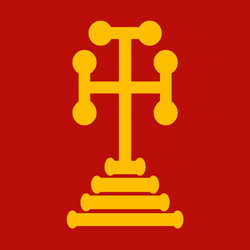Rášidský chalífát
| Rášidský chalífát الخلافة الراشدة
| |||||||||||||||||
Geografie
| |||||||||||||||||
9 400 000 km² | |||||||||||||||||
| Obyvatelstvo | |||||||||||||||||
21 400 000 | |||||||||||||||||
islámské (státní, jediné uznané) ostatní: křesťanské, zoroastriánské, judaistické, arabské polyteistické, babylónské, staroegyptské, manicheistické, mandejské, buddhistické | |||||||||||||||||
| Státní útvar | |||||||||||||||||
| Státní útvary a území | |||||||||||||||||
| |||||||||||||||||
Rášidský chalífát (arabsky الخلافة الراشدية, al-Chiláfah ar-Rášidijjah) byla islámská vojenská říše založená po smrti proroka Mohameda (632) a trvající v období vlády prvních čtyř chalífů do roku 661.
Chalífové
 Abd Alláh Abú Bakr (632–634)
Abd Alláh Abú Bakr (632–634) Umar ibn al-Chattáb (634–644)
Umar ibn al-Chattáb (634–644) Uthmán ibn Affán (644–656)
Uthmán ibn Affán (644–656) Alí ibn Abí Tálib (656–661)
Alí ibn Abí Tálib (656–661)
Související články
Externí odkazy
 Obrázky, zvuky či videa k tématu Rášidský chalífát na Wikimedia Commons
Obrázky, zvuky či videa k tématu Rášidský chalífát na Wikimedia Commons
Reference
V tomto článku byl použit překlad textu z článku Rášidský kalifát na slovenské Wikipedii.
Média použitá na této stránce
A flag used during the Umayyad dynasty (660–750)
Autor: Dragovit, Licence: CC BY-SA 4.0
The Byzantine "Calvary cross potent" as icon or hypothetical banner of the Byzantine Empire. The Calvary cross standing on a number of steps was minted on solidus coins (also shows without the steps on tremissis coins) by various Byzantine emperors, mainly in the 7th century during the reign of Heraclian dynasty and after.
Autor: Petermaleh, Licence: CC BY-SA 3.0
The vector version of the iconic calligraphy of the 2nd Rashidun Chalif, Umar ibn Al-Khattāb, which is prominent in the Hagia Sofia in Istanbul, Turkey.
(c) Mohammad adil from en.wikipedia.org, CC BY-SA 3.0
Empire of the Rashidun Caliphate at its peak.
Autor: MWahaiibii, Licence: CC BY-SA 4.0
Based on David Nicolle "Armies of the Muslim Conquest" illustrations by Angus McBride. And Martin Hinds "The Banners and Battle Cries of the Arabs at Siffin" Al-Abhath XXIV
Artist's rendition of the banner of the late Sassanid Empire.
(c) Mohammad adil at en.wikipedia, CC BY-SA 3.0
Как менялись границы арабского халифата
Autor: Petermaleh, Licence: CC BY-SA 3.0
The vector version of the iconic calligraphy of the 1st Rashidun Chalif, Abu Bakr, which is prominent in the Hagia Sofia in Istanbul, Turkey.
This Black flag has been the flag of various Afghan rulers: Flag of Zengid dynasty and Flag of Afghanistan (pre-1901) and the flag of the Black Guards. This flag has also been the flag of the Sadozai Sudhan rulers of Sidhnuti This can be used to represent the Abbasid Caliphate, since while the concept of rectangular national flags did not exist during Abbasid times, black was the dynastic color of the Abbasids and the "black banner" of the Abbasids is famous in Islamic history. It was also used by many Islamic dynasties in different regions of the world till the late 19th century. It is also used by anarchist groups and pirates.
Also has been the flag of Makhnovshchina.Autor: Petermaleh, Licence: CC BY-SA 3.0
The vector version of the iconic calligraphy of the 4th Rashidun Chalif, Ali bin Abi Talib, which is prominent in the Hagia Sofia in Istanbul, Turkey.
fictional Flag of Rashidun Caliphate (631-661)
The vector version of the iconic calligraphy of the 3rd Rashidun Chalif, Uthman ibn Affan, which is prominent in the Hagia Sofia in Istanbul, Turkey














